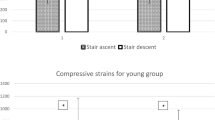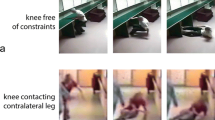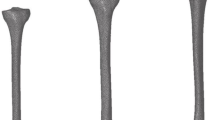Abstract
Purpose
Understanding the femur load environment during daily activity is necessary for the understanding of risk of femoral pain, pain related falls, and femoral fractures, which could help the design of osteogenic exercises or the preventative methods for older adults.
Methods
Using the finite element femur analysis, this study was to estimate the femoral strains at 9 cross-sections along the long axis of femur for stair ascent and descent (n = 17; age: 50–65 years). Motion analysis and inverse dynamics were combined with musculoskeletal modelling and optimization, then were used as input to a 3-D femur model to estimate femoral strains. Strains at the hip contact force peaks were calculated.
Results
The compressive and tensile strains during stair descent were greater than ascent for all or most cross-sections, especially for the proximal cross-sections of the femur: stair ascent produced − 324.0 ± 103.8 to − 483.7 ± 191.0 µε compressive strains and descent produced − 608.8 ± 288.4 to 1016.0 ± 444.1 µε; stair ascent produced 336.2 ± 105.4 to 391.8 ± 136.9 µε tensile strains and descent produced 546.9 ± 252.8 to 741.7 ± 333.6 µε.
Conclusion
Strains represent the material deformation effect on the bone due to the sum of all the bone external loads. Using bone strains could help future studies analyze load conditions in a more comprehensive way for other physical activities, which predicts the risk of stress fractures and tests if alternative methods (gait type change) could reduce stress and strain effectively.









Similar content being viewed by others
Availability of Data and Material
Not applicable.
Code Availability
Not applicable.
References
Aamodt A, Lund-Larsen J, Eine J, Benum P, Husby OS. In vivo measurements show tensile axial strain in the proximal lateral aspect of the human femur. J Orthop Res. 1997;15(6):927–31.
Adler R. Bisphosphonates and atypical femoral fractures. Curr Opin Endocrinol Diabetes Obes. 2016;23(6):430–4.
Anderson DE, Madigan ML. Effects of age-related differences in femoral loading and bone mineral density on strains in the proximal femur during controlled walking. J Appl Biomech. 2013;29:505–16.
Arnold EM, Ward SR, Lieber RL, Delp SL. A model of the lower limb for analysis of human movement. Ann Biomed Eng. 2010;38(2):269–79.
Bergmann G, Deuretzbacher G, Heller M, Graichen F, Rohlmann A, Strauss J, Duda GN. Hip contact forces and gait patterns from routine activities. J Biomech. 2001;34:859–71.
Blanchard R, Dejaco A, Bongaers E, Hellmich C. Intravoxel bone micromechanics for microCT-based finite element simulations. J Biomech. 2013;46(15):2710–21.
Burstein AH, Reilly DT, Martens M. Aging of bone tissue: mechanical properties. J Bone Jt Surg. 1976;58(1):82–6.
Chang MW, Liu HT, Huang CY, Chien P-C, Hsieh H-Y, Hsieh C-H. Location of femoral fractures in patients with different weight classes in fall and motorcycle accidents: a retrospective cross-sectional analysis. Int J Environ Res Public Health. 2018;15(6):1082–90.
Cristofolini L. Influence of thigh muscles on the axial strains in a proximal femur during early stance in gait. J Biomech. 1995;28(5):617.
Deng C, Gillette JC, Derrick TR. Femoral neck stress in older adults during stair ascent and descent. J Appl Biomech. 2018;34(3):191–8.
Duda GN, Heller M, Albinger J, Schulz O, Schneider E, Claes L. Influence of muscle forces on femoral strain distribution. J Biomech. 1998;31(9):841–6.
Dunlop DG, Brenkel IJ. The supracondylar intramedullary nail in elderly patients with distal femoral fractures. Injury. 1999;30(7):475–84.
Edwards B, Miller R, Derrick T. Femoral strain during walking predicted with muscle forces from static and dynamic optimization. J Biomech. 2016;49(7):1206–13.
Edwards B, Schnitzer J, Troy L. Bone mineral loss at the proximal femur in acute spinal cord injury. Osteoporos Int. 2013;24(9):2461–9.
Edwards B, Schnitzer J, Troy L. Torsional stiffness and strength of the proximal tibia are better predicted by finite element models than DXA or QCT. J Biomech. 2013;46(10):1655–62.
Glitsch U, Baumann W. The three-dimensional determination of internal loads in the lower extremity. J Biomech. 1997;30(11–12):1123–31.
Haider IT, Schneider P, Michalski A. Influence of geometry on proximal femoral shaft strains: implications for atypical femoral fracture. Bone. 2018;110:295–303.
Hall M, Stevermer CA, Gillette JC. Muscle activity amplitudes and co-contraction during stair ambulation following anterior cruciate ligament reconstruction. J Electromyogr Kinesiol. 2015;25(2):298–304.
Hong YNG, Shin CS. Gender differences of sagittal knee and ankle biomechanics during stair to ground descent transition. Clin Biomech. 2015;30(10):1210–7.
Jacobs JV. A review of stairway falls and stair negotiation: lessons learned and future needs to reduce injury. Gait Posture. 2016;49:159–67.
Kersh ME, Martelli S, Zebaze R, Seeman E, Pandy MG. Mechanical loading of the femoral neck in human locomotion. J Bone Miner Res. 2018;33(11):1999–2006.
Keyak JH, Skinner H, Fleming J. Effect of force direction on femoral fracture load for two types of loading conditions. J Orthop Res. 2001;19(4):539–44.
Khow KSF, Paterson F, Shibu P. Outcomes between older adults with atypical and typical femoral fractures are comparable. Injury. 2017;48(2):394–8.
Lawson E, Madougou S, Chigblo P. Ipsilateral proximal and shaft femoral fractures. Chin J Traumatol. 2017;20(3):155–7.
Malandrino A, Fritsch A, Lahayne O, Kropik K, Redl H, Noailly J, Lacroix D, Hellmich C. Anisotropic tissue elasticity in human lumbar vertebra, by means of a coupled ultrasound-micromechanics approach. Mater Lett. 2012;78:154–8.
Maravic M, Ostertag A, Cohen-Solal M. Subtrochanteric/femoral shaft versus hip fractures: incidences and identification of risk factors. J Bone Miner Res. 2012;27:130–7.
Martelli S, Pivonka P, Ebeling PR. Femoral shaft strains during daily activities: implications for atypical femoral fractures. Clin Biomech. 2014;29(8):869–76.
McMahon T. Size and shape in biology. Science. 1973;179:1201–4.
Melton LJ, Crowson CS, O’Fallon WM. Fracture incidence in Olmsted County, Minnesota: comparison of urban with rural rates and changes in urban rates over time. Osteoporos Int. 1999;9(1):29–37.
Miura T, Kijima H, Ishikawa N, Ebina T, Tani T, Chida S, Suzuki T, Yumto S, Tazawa H, Miyakoshi N, Shimada Y. Comparison of atypical and osteoporotic femoral shaft fractures in the elderly: a multicenter study. Adv Orthop. 2018;2018:1–5.
Morgan EF, Bayraktar HH, Keaveny TM. Trabecular bone modulus-density relationships depend on anatomic site. J Biomech. 2003;36(7):897–904.
Munih M, Kralj A, Bajd T. Bending moments in lower extremity bones for two standing postures. J Biomed Eng. 1992;14(4):293–302.
Nieves JW, Bilezikian JP, Lane JM, Einhorn TA, Wang Y, Steinbuch M, Cosman F. Fragility fractures of the hip and femur: incidence and patient characteristics. Osteoporos Int. 2010;21(3):399–408.
Polgar K, Gill HS, Viceconti M, Murray DW, O'Connor JJ. Strain distribution within the human femur due to physiological and simplified loading: finite element analysis using the muscle standardized femur model. Proc Inst Mech Eng C J Eng Med. 2003;217(3):173–89.
Rowbotham SK, Blau S, Hislop-Jambrich J, Francis V. Fatal falls involving stairs: an anthropological analysis of skeletal trauma. Forensic Sci Med Pathol. 2018;14(2):152–62.
Schileo E, Taddei F, Malandrino A, Cristofolini L, Viceconti M. Subject-specific finite element models can accurately predict strain levels in long bones. J Biomech. 2007;40(13):2982–9.
Sivananthan S, Sherry E. Mercer's textbook of orthopaedics and trauma. 10th ed. New York City: Oxford Univ Press; 2012.
Smektala R, Endres HG, Dasch B, Maier C, Trampisch HJ, Bonnaire F, Pientka L. The effect of time-to-surgery on outcome in elderly patients with proximal femoral fractures. BMC Musculoskelet Disord. 2008;9(1):171.
Speirs AD, Heller MO, Duda GN, Taylor WR. Physiologically based boundary conditions in finite element modelling. J Biomech. 2007;40(10):2318–23.
Streubel PN, Ricci WM, Wong A, Gardner MJ. Mortality after distal femur fractures in elderly patients. Clin Orthop Relat Res. 2011;469(10):1188.
Taylor ME, Tanner KE, Freeman MA, Yettram AL. Stress and strain distribution within the intact femur: compression or bending? Med Eng Phys. 1996;18(2):122–31.
Van Sint JS. The VAKHUM project: virtual animation of the kinematics of the human. Theor Issues Ergon Sci. 2005;6(3–4):277–9.
Vaughan C, Davis B, O’Connor J. Dynamics of human gait. Champaign: Human Kinetics; 1992.
Viceconti M, Taddei F, Cristofolini L, Martelli S, Falcinelli C, Schileo E. Are spontaneous fractures possible? An example of clinical application for personalised, multiscale neuro-musculo-skeletal modelling. J Biomech. 2012;45(3):421–6.
Yu B, Gabriel D, Noble L, An KN. Estimate of the optimum cutoff frequency for the Butterworth low-pass digital filter. J Appl Biomech. 1999;15(3):318–29.
Funding
The Funding was provided by Chinese Universities Scientific Fund (Grant No. 2020063).
Author information
Authors and Affiliations
Contributions
Three authors were involved with the study and the preparation of the manuscripts: Chen Deng was fully involved in research design, data collection/analysis, manuscript writing and reviewing; Jason Gillette was involved in research design and manuscript reviewing/editing; Timothy Derrick was involved in research design, data collection and manuscript reviewing/editing. All authors have read and concurred with the content in the final manuscript and agreed to submit this manuscript to Journal of Science in Sport and Exercise. The material within the manuscript has not been and will not be submitted for publication elsewhere except as an abstract.
Corresponding author
Ethics declarations
Conflict of interest
Author Timothy Derrick was not involved in the journal’s review of, or decisions related to, this manuscript.
Ethics approval
ISU IRB # 17-296; approved by Iowa State University Human Subjects Review Board.
Consent to participate
All participants signed written informed consent that had been approved by the Iowa State University Human Subjects Review Board.
Rights and permissions
About this article
Cite this article
Deng, C., Gillette, J.C. & Derrick, T.R. Finite Element Analysis of Femoral Strains in Older Adults During Stair Ascent and Descent. J. of SCI. IN SPORT AND EXERCISE 4, 168–179 (2022). https://doi.org/10.1007/s42978-021-00141-1
Received:
Accepted:
Published:
Issue Date:
DOI: https://doi.org/10.1007/s42978-021-00141-1




